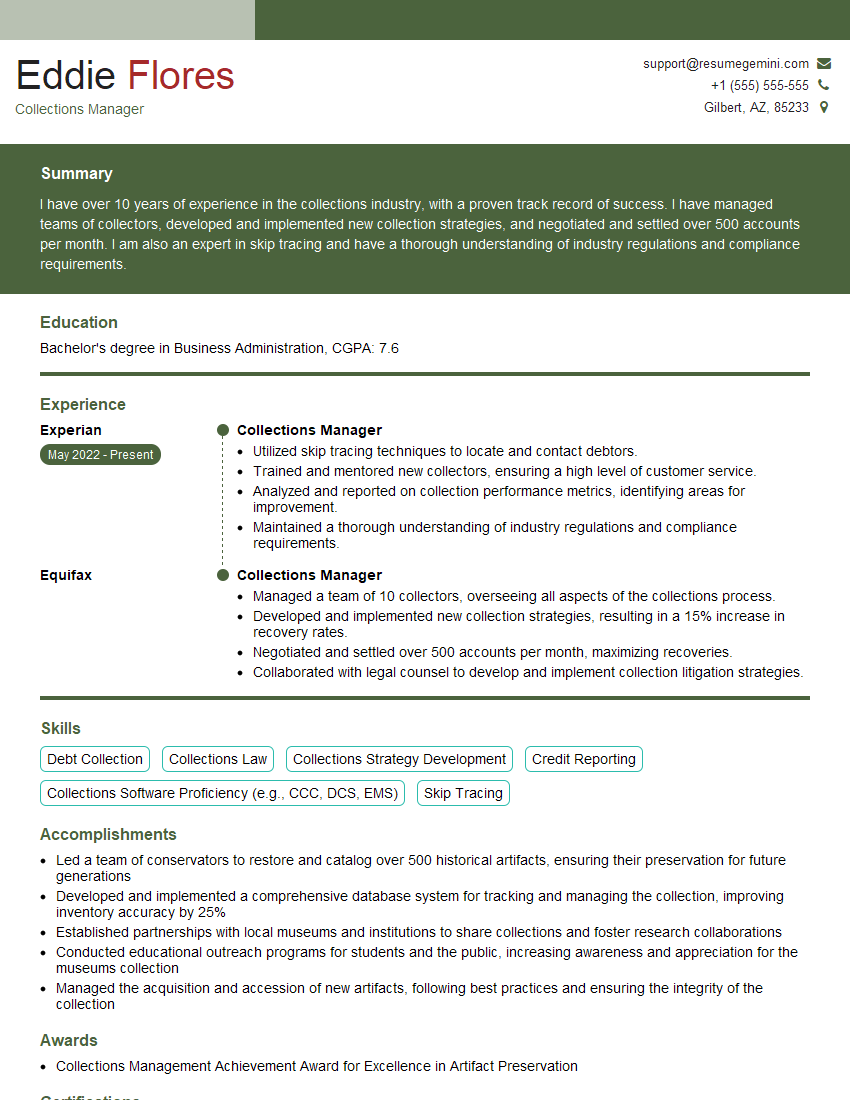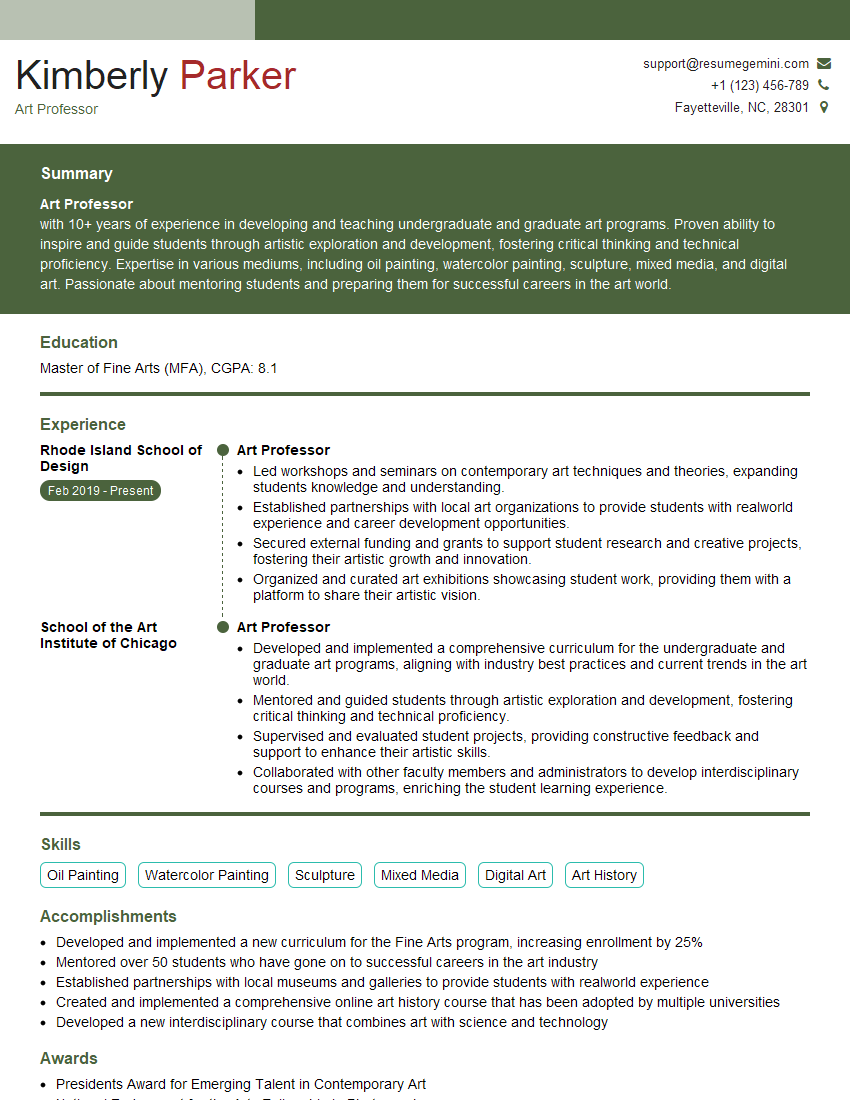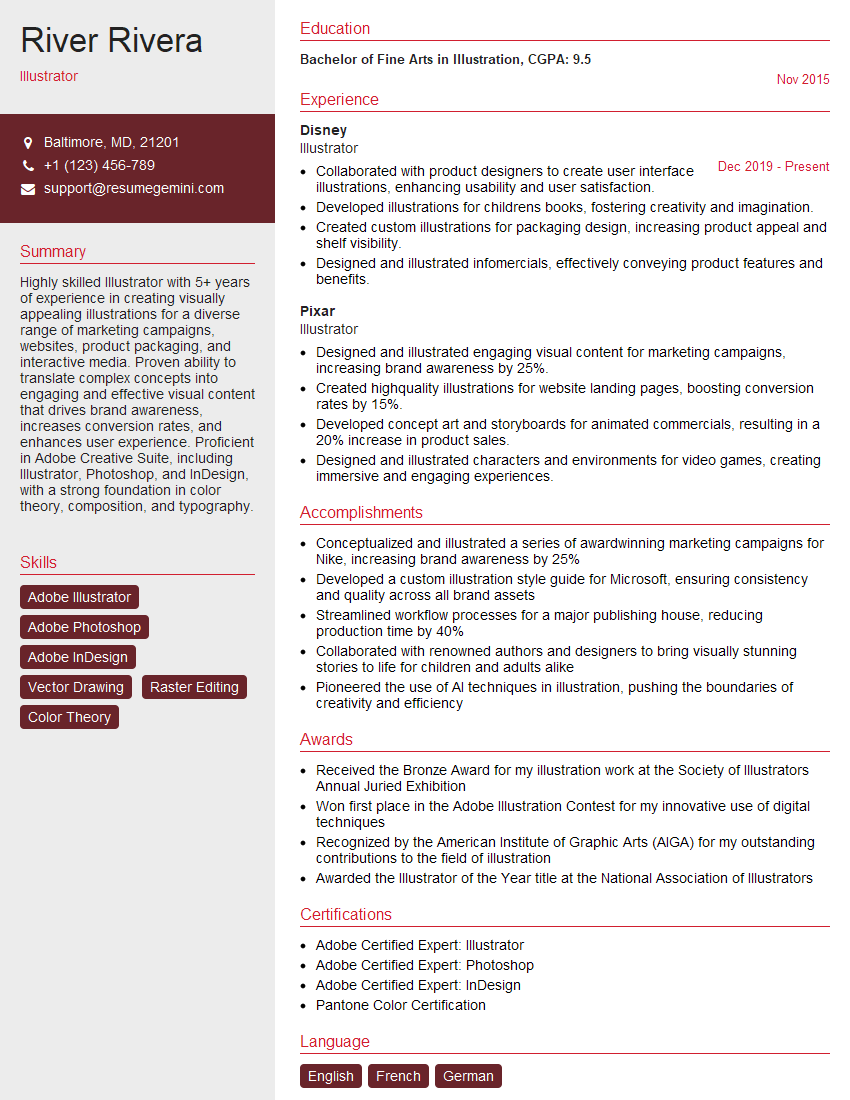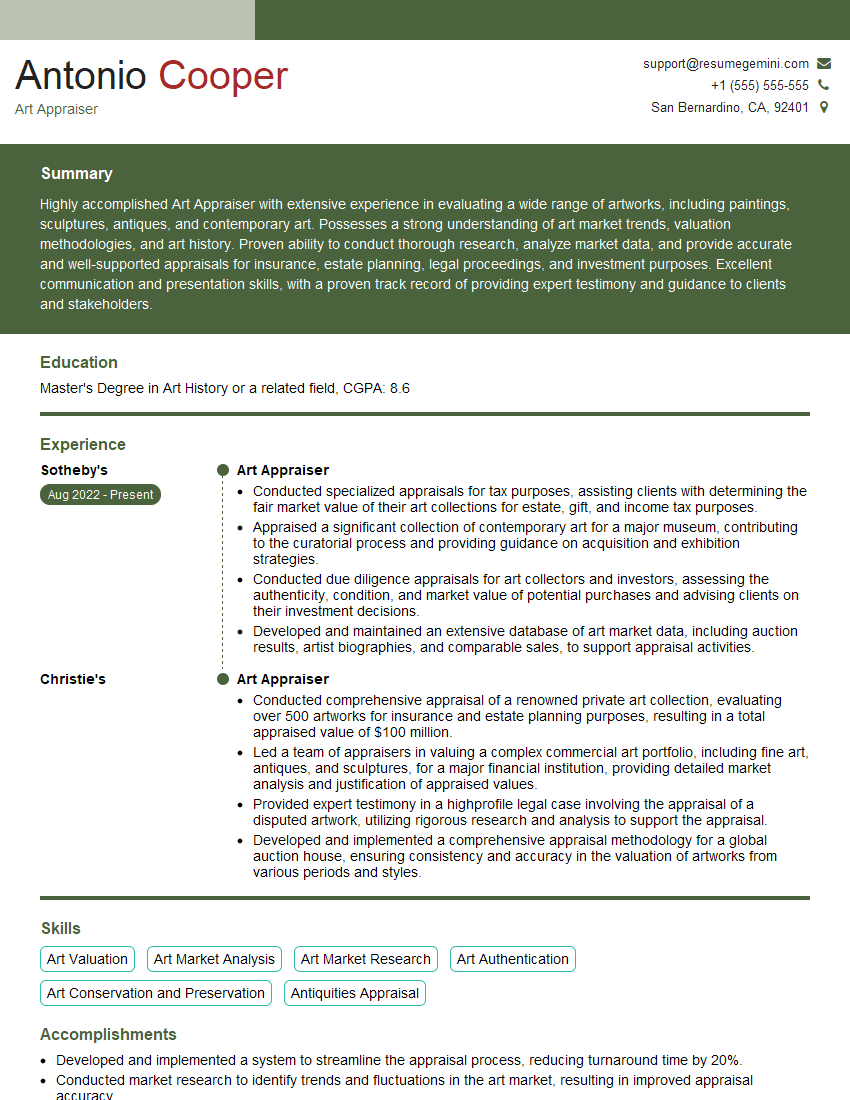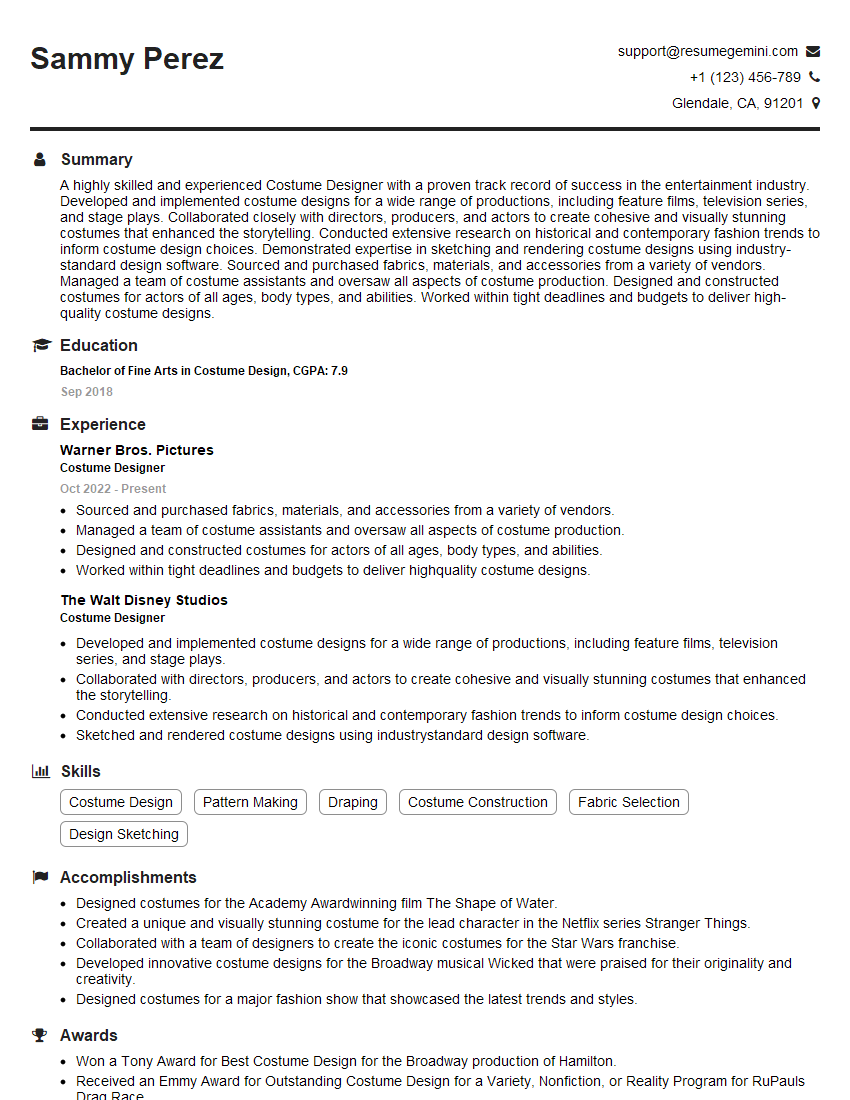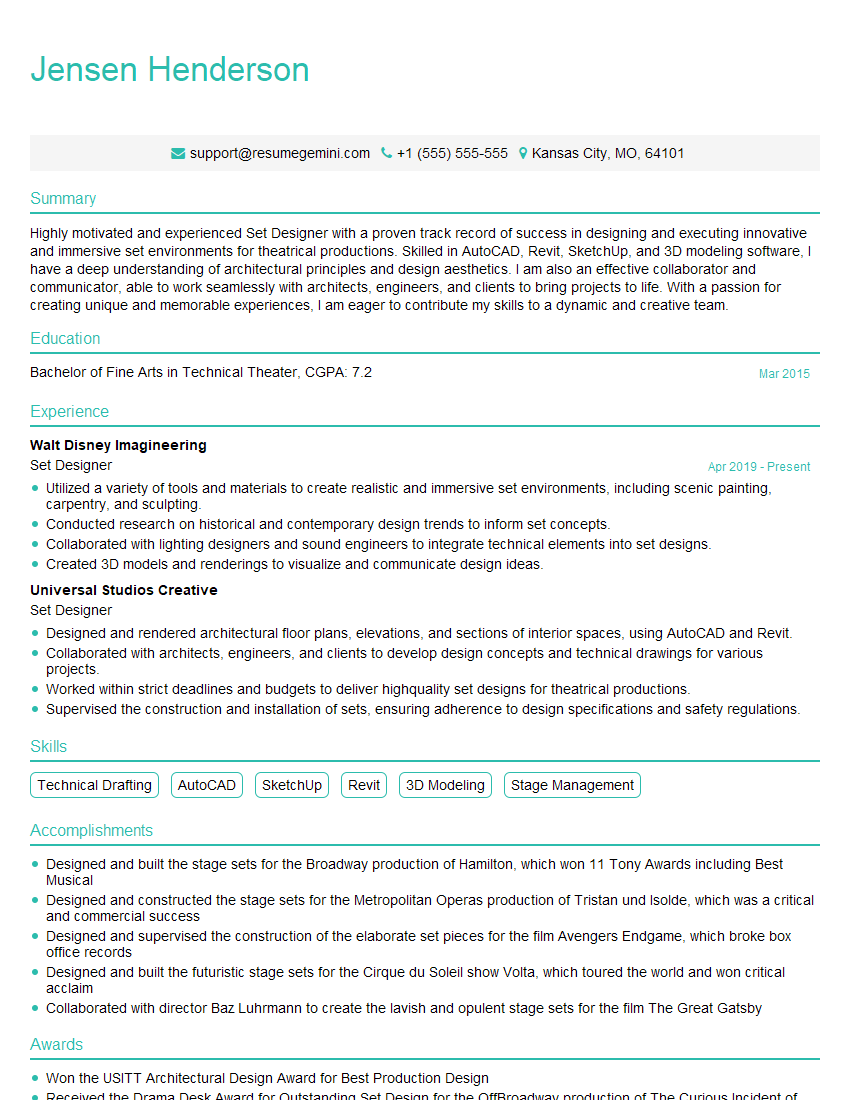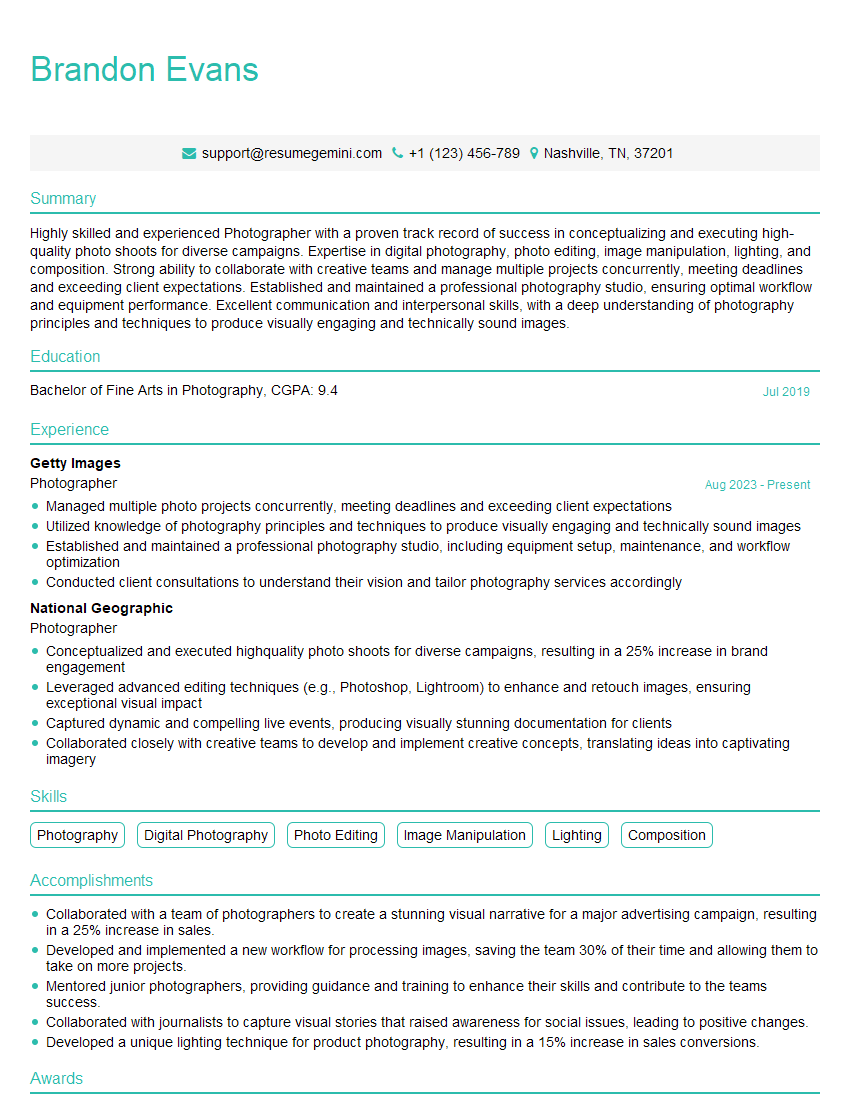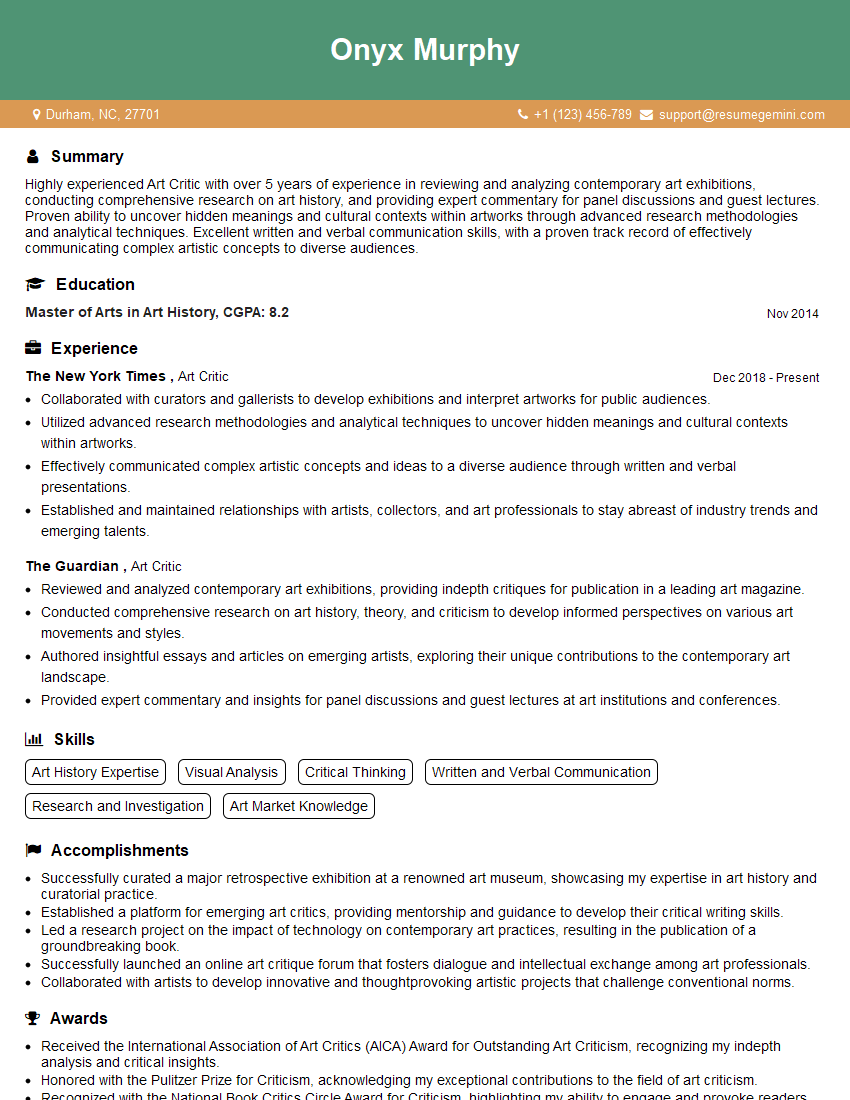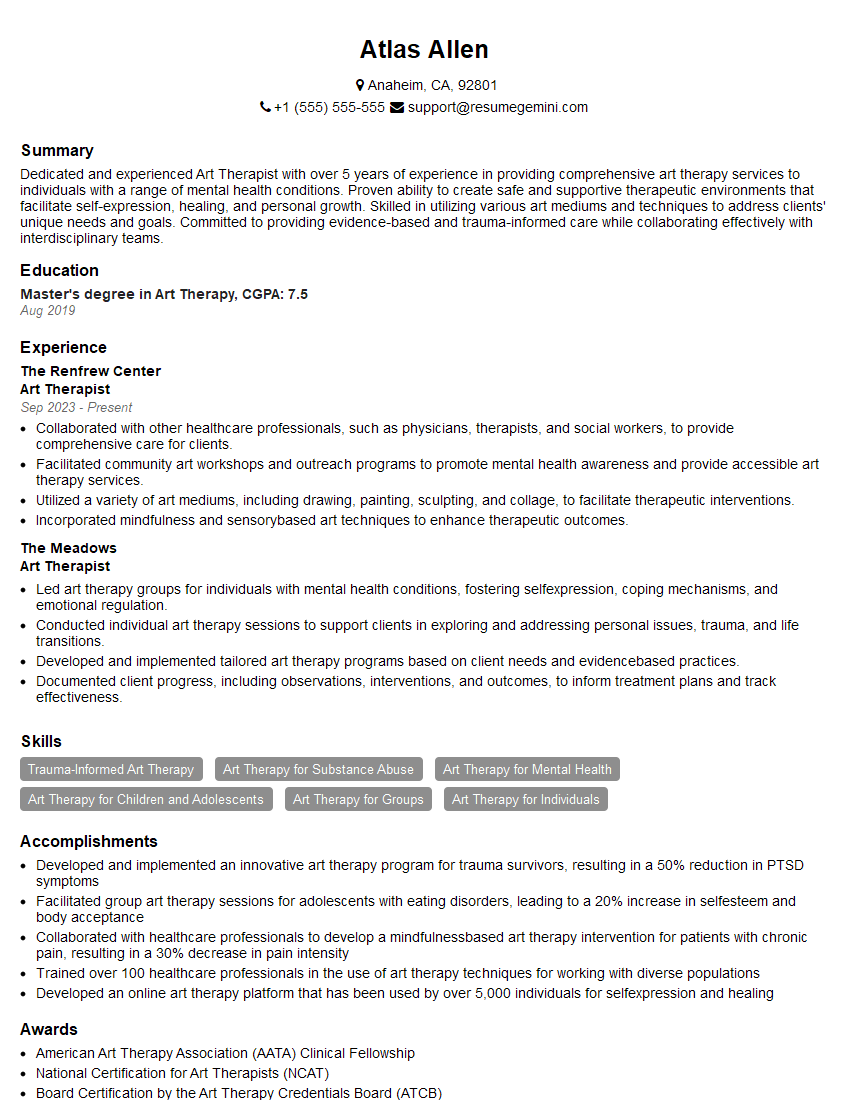The thought of an interview can be nerve-wracking, but the right preparation can make all the difference. Explore this comprehensive guide to Basic Knowledge of Art Theory interview questions and gain the confidence you need to showcase your abilities and secure the role.
Questions Asked in Basic Knowledge of Art Theory Interview
Q 1. Define the term ‘aesthetic experience’.
An aesthetic experience is a subjective encounter with an object or phenomenon that evokes a sense of beauty, pleasure, or meaning. It’s not just about visual appeal; it encompasses emotional, intellectual, and even spiritual responses. Think of the feeling you get when listening to your favorite piece of music, or when standing before a breathtaking landscape. These are aesthetic experiences, shaped by personal background, cultural context, and individual sensitivities. It’s a deeply personal and multifaceted engagement with the world around us, transcending mere sensory perception.
For example, one person might find immense aesthetic pleasure in the intricate detail of a Renaissance painting, while another might be moved by the raw emotionality of an abstract expressionist canvas. Both are valid aesthetic experiences, highlighting the subjective nature of beauty and artistic appreciation.
Q 2. Explain the difference between representational and non-representational art.
The distinction between representational and non-representational art lies in their relationship to the natural world. Representational art aims to depict recognizable objects or scenes from the real world. Think of a portrait, a landscape painting, or even a still life – these artworks strive to create a visual likeness of something observable. The degree of realism can vary greatly, from photorealistic paintings to more stylized depictions.
Conversely, non-representational art, also known as abstract art, doesn’t attempt to depict anything recognizable from the real world. It focuses instead on elements like color, line, shape, texture, and form, independent of any representational intent. Think of a Jackson Pollock painting, with its spontaneous drips and splashes of paint – its beauty lies not in depicting something specific, but in the interplay of abstract visual elements themselves.
Essentially, representational art is about what is depicted, while non-representational art is about how it is depicted.
Q 3. Describe the key principles of design (e.g., balance, contrast, unity).
The principles of design are fundamental tools used by artists and designers to create visually appealing and effective works. They are interconnected and often work together to achieve a cohesive composition.
- Balance: Refers to the visual weight distribution in a composition. Symmetrical balance creates a sense of stability and formality, while asymmetrical balance uses different visual weights to achieve equilibrium in a more dynamic way. Think of a perfectly balanced scale versus a more free-form mobile.
- Contrast: Juxtaposes opposing elements to create visual interest and emphasis. This can involve contrasting colors, values (light and dark), textures, shapes, or sizes. Think of a bright red poppy against a field of deep green.
- Unity: Creates a sense of wholeness and coherence in the artwork. This is achieved through repetition of elements, consistent use of color palettes, or a clear visual hierarchy.
- Emphasis: Draws the viewer’s eye to a particular point or area. This can be accomplished through size, color, contrast, or placement.
- Movement: Guides the viewer’s eye through the composition, creating a sense of visual flow. This is often done through lines, shapes, and the arrangement of elements.
- Pattern: The repetition of elements to create visual rhythm and texture.
- Proportion: Refers to the relative size and scale of different elements within a composition.
- Rhythm: Creates a sense of visual tempo and movement through repetition, variation, and progression.
These principles can be applied across various art forms, from painting and sculpture to graphic design and architecture, influencing how we perceive and respond to visual information.
Q 4. What are the main characteristics of Baroque art?
Baroque art, flourishing primarily in Europe from the late 16th to mid-18th centuries, is characterized by its dramatic, ornate, and highly emotional style. Key characteristics include:
- Dramatic use of light and shadow (chiaroscuro): Creating a strong sense of depth and emotion.
- Intense emotional expression: Often depicting religious scenes with fervent passion or portraying human emotion in a heightened way.
- Dynamic composition: Using diagonal lines, swirling movement, and complex arrangements of figures to create a sense of energy and drama.
- Ornate detail and decoration: Featuring elaborate ornamentation, rich textures, and a lavish use of color.
- Grand scale and grandeur: Many Baroque works were created for large spaces like churches and palaces, reflecting the power and opulence of the era.
- Strong sense of theatricality: Artworks frequently evoke the feeling of a stage performance, engaging the viewer’s senses intensely.
Examples include the works of Caravaggio, Bernini, and Rubens, showcasing the dramatic flair and emotional depth that define this artistic period.
Q 5. Discuss the impact of Impressionism on subsequent art movements.
Impressionism, with its focus on capturing fleeting moments and the effects of light, profoundly impacted subsequent art movements. Its revolutionary approach to painting—using short, visible brushstrokes, open compositions, and an emphasis on capturing the subjective experience of the artist—liberated artists from the constraints of academic realism.
- Post-Impressionism: Artists like Van Gogh, Cézanne, and Gauguin built upon Impressionism’s techniques but explored more personal expression and symbolic representation. They moved beyond the purely visual focus of Impressionism, introducing greater emotional intensity and individual styles.
- Fauvism: This early 20th-century movement intensified Impressionism’s use of color, employing bold, non-naturalistic hues to express emotion rather than accurately depict reality.
- Expressionism: Building on the emotional intensity of Post-Impressionism, Expressionist artists used distorted forms and vibrant colors to express inner feelings and anxieties.
Impressionism’s legacy is evident in the development of modern and contemporary art, demonstrating its lasting influence on artistic experimentation and the expression of individual vision.
Q 6. Explain the concept of ‘artistic movement’.
An artistic movement is a group of artists who share similar ideas, styles, or goals. These artists are often active within a specific time period and geographical location, and their shared aesthetic approaches lead to recognizable characteristics that differentiate them from other groups. Movements are influenced by social, political, and technological changes, as well as by the artistic dialogues and conversations between artists themselves.
Consider the Impressionist movement: artists like Monet, Renoir, and Degas, though possessing individual styles, shared a common approach to painting that distinguished their work from the prevailing academic styles of their time. This shared vision, reflected in their works, makes ‘Impressionism’ a distinct artistic movement. The emergence of new ideas, techniques, and philosophies frequently prompts the formation of new artistic movements, illustrating a dynamic interplay between art and societal evolution.
Q 7. What is the significance of perspective in Renaissance art?
Perspective in Renaissance art holds immense significance, marking a revolutionary shift in artistic representation. Before the Renaissance, artists primarily used a flat, two-dimensional style. The rediscovery of classical Greek and Roman knowledge, along with advancements in mathematics and optics, led to the development of linear perspective.
Linear perspective creates the illusion of three-dimensional space on a two-dimensional surface. It uses converging lines to create the effect of depth and distance, with objects appearing smaller and more distant as they recede toward a vanishing point on the horizon. This technique allowed Renaissance artists to create more realistic and immersive depictions of the world, greatly enhancing the sense of depth and spatial relationships in their paintings and sculptures.
Masterpieces such as Masaccio’s ‘Tribute Money’ perfectly illustrate the impact of linear perspective on the representation of realistic space. Its use profoundly affected the development of Western art, establishing new standards for realism and naturalism and impacting art for centuries to come.
Q 8. Describe the differences between realism and surrealism.
Realism and Surrealism, while both artistic movements, represent drastically different approaches to depicting reality. Realism, dominant in the 19th century, aims for a truthful and accurate representation of the observable world. Artists meticulously render details, striving for visual fidelity. Think of Gustave Courbet’s paintings, which depict everyday life with stark honesty. Surrealism, emerging in the early 20th century, on the other hand, explores the realm of the unconscious mind and dreams. It juxtaposes unrelated objects and imagery to create dreamlike, illogical scenes, defying conventional notions of reality. Salvador Dali’s melting clocks are a quintessential example of this dreamlike, illogical aesthetic. The key difference lies in their relationship with reality: Realism seeks to mirror it, while Surrealism actively subverts it.
Q 9. Explain the concept of ‘form’ in art.
In art, ‘form’ refers to the visual elements of a work, encompassing its shape, line, color, texture, volume, and space. It’s how the artist arranges these elements to create a cohesive and meaningful composition. Think of a sculpture: its form is determined by its three-dimensional shape and how light interacts with its surfaces. In a painting, form encompasses the artist’s use of brushstrokes, color relationships, and spatial arrangements to create depth and visual interest. Form is not merely about the subject matter but the visual structure of the artwork itself. Analyzing form involves understanding how these elements work together to convey emotion, meaning, and artistic intent. For example, the sharp, angular forms in a Cubist painting communicate a different feeling than the soft, rounded forms in a Romantic landscape.
Q 10. What are the various types of art mediums?
Art mediums are the materials and techniques artists use to create their work. They are incredibly diverse! We can broadly categorize them as:
- Painting: Utilizing pigments suspended in a binder (like oil, acrylic, watercolor, tempera) applied to a surface (canvas, wood panel, paper).
- Drawing: Employing various tools like pencils, charcoal, pastels, or inks on paper or other surfaces.
- Sculpture: Creating three-dimensional forms using materials like clay, stone, wood, metal, or found objects.
- Printmaking: Creating multiple impressions from a single matrix (woodcut, etching, lithography, screen printing).
- Photography: Capturing images using light-sensitive materials.
- Digital Art: Utilizing computer software and technology to create images and animations.
- Mixed Media: Combining various mediums in a single artwork.
The choice of medium profoundly impacts the final artwork’s aesthetic qualities and expressive possibilities. For instance, the fluidity of watercolor contrasts sharply with the precision of engraving.
Q 11. Compare and contrast Minimalism and Pop Art.
Minimalism and Pop Art, though both influential 20th-century movements, offer contrasting approaches to art. Minimalism, emerging in the 1960s, emphasizes extreme simplicity and reduction. Works often feature basic geometric forms, limited color palettes, and a rejection of expressive brushstrokes. Think of Donald Judd’s rectangular sculptures: their essence lies in their pure, unadorned form. Pop Art, also a 1960s phenomenon, draws inspiration from popular culture and mass media. Artists utilize imagery from advertising, comics, and everyday objects, often employing techniques of repetition and appropriation. Andy Warhol’s Campbell’s Soup cans are a prime example of Pop Art’s appropriation of commonplace imagery. While Minimalism strives for essential purity, Pop Art embraces the vibrant, often superficial, aspects of consumer society. Both movements, however, challenged traditional art conventions in their own unique ways.
Q 12. How does context influence the interpretation of a work of art?
Context plays a crucial role in interpreting art. The historical, social, cultural, and even physical environment surrounding an artwork significantly impacts how viewers perceive it. A painting might be seen differently in a museum setting versus a private collection. Its meaning can shift depending on the historical period in which it’s viewed, the artist’s biography, or the prevailing cultural norms. For instance, a seemingly simple portrait might reveal deeper meanings when considered within the social context of the time it was painted, revealing insights into class, gender, or power dynamics. Understanding the context enriches the interpretation, revealing layers of meaning beyond the immediate visual experience.
Q 13. Explain the role of patronage in art history.
Patronage has been a cornerstone of art history, referring to the system of financial support artists received from wealthy individuals, institutions, or governments. Patrons, ranging from powerful monarchs to private collectors, commissioned artworks, ensuring artists could dedicate their time to creation. Patronage shaped the types of art produced, influencing subject matter, style, and artistic choices. The Renaissance, for example, flourished thanks to the patronage of the Medici family and the Catholic Church. The artistic styles and subjects favored by the patron often became dominant trends. Without patronage, many masterpieces might never have been created, highlighting its vital role in shaping artistic production and cultural legacy.
Q 14. Describe the concept of artistic intention.
Artistic intention refers to the artist’s aims, goals, and motivations in creating a work of art. It encompasses their ideas, emotions, and the message they intend to convey. While the artist’s intention isn’t always explicitly stated, understanding it helps us delve deeper into the work’s meaning. However, it’s crucial to remember that the artwork’s meaning isn’t solely determined by the artist’s intention; viewers bring their own interpretations, influenced by their experiences and perspectives. The interplay between the artist’s intention and the viewer’s interpretation is what makes art a dynamic and engaging experience. Sometimes, an artist’s intention might be quite different from how the work is ultimately perceived.
Q 15. Discuss the relationship between art and society.
Art and society are inextricably linked; they exist in a constant dialogue. Society shapes the art produced, reflecting its values, beliefs, and anxieties. Conversely, art can profoundly influence society, challenging norms, sparking conversations, and even driving social change.
- Reflection of Society: Think of the stark realism of 19th-century artists like Gustave Courbet, who depicted the lives of ordinary working people, reflecting the social realities of his time. Or consider the protest art of the 1960s and 70s, which directly addressed issues of war and civil rights.
- Shaping Society: Picasso’s Guernica, a powerful anti-war statement, became a symbol of the horrors of conflict and impacted public opinion. Similarly, feminist art throughout history has helped challenge gender stereotypes and societal expectations.
- Artistic Patronage: Throughout history, art’s creation has often been heavily influenced by its patrons – whether wealthy individuals, the church, or the state. Their tastes and preferences directly impact the types of art produced.
Understanding this relationship is crucial for analyzing art within its historical and cultural context. It allows us to appreciate how art not only mirrors but also actively contributes to the evolution of societal structures and values.
Career Expert Tips:
- Ace those interviews! Prepare effectively by reviewing the Top 50 Most Common Interview Questions on ResumeGemini.
- Navigate your job search with confidence! Explore a wide range of Career Tips on ResumeGemini. Learn about common challenges and recommendations to overcome them.
- Craft the perfect resume! Master the Art of Resume Writing with ResumeGemini’s guide. Showcase your unique qualifications and achievements effectively.
- Don’t miss out on holiday savings! Build your dream resume with ResumeGemini’s ATS optimized templates.
Q 16. What is the difference between art criticism and art history?
While both art criticism and art history examine art, they approach it from different perspectives. Art history focuses on the chronological development of art, tracing stylistic changes, and exploring the cultural context in which art was created. Art criticism, on the other hand, evaluates individual works of art, analyzing their aesthetic qualities, meaning, and impact.
- Art History: Think of researching the evolution of Impressionism, understanding its historical roots in the changing social and technological landscape of 19th-century France. Art historians study the lives of artists, their influences, and how their work reflects the historical moment.
- Art Criticism: An art critic might analyze a specific painting, discussing its use of color, composition, and symbolism to interpret its meaning and evaluate its effectiveness. They might consider its impact on the viewer and its place within a broader artistic conversation.
While distinct, these fields are interconnected. A strong understanding of art history provides context for art criticism, allowing critics to better understand the artwork’s significance. Similarly, insightful art criticism contributes to the ongoing discussion and interpretation of art history.
Q 17. Explain the role of symbolism in art.
Symbolism in art uses visual elements to represent ideas, concepts, or emotions beyond their literal meaning. It acts as a visual language, allowing artists to communicate complex narratives or themes in a concise and evocative manner. Symbols can be culturally specific, universally understood, or even created uniquely by an artist.
- Cultural Symbols: The lily often symbolizes purity in Western art, while the lotus flower holds similar significance in Eastern cultures. These culturally specific meanings add layers of interpretation.
- Universal Symbols: The color red often conveys passion or danger, while the color black might represent death or mourning. These are broadly understood symbols with near-universal meanings.
- Artist-Specific Symbols: An artist might develop personal symbols representing key themes in their work. For instance, a recurring image of a bird might symbolize freedom or hope in the artist’s oeuvre.
Recognizing and interpreting symbolism requires understanding the cultural context of the art and paying close attention to the artist’s intentions and the visual details of the work. It’s a crucial aspect of understanding the deeper meaning and impact of art.
Q 18. How do artists use line, shape, and color to create meaning?
Line, shape, and color are fundamental elements of art, and artists use them skillfully to create meaning and evoke specific feelings. Each element possesses unique expressive qualities.
- Line: A single line can suggest movement (a sweeping curve), energy (jagged lines), or stillness (a horizontal line). Consider the powerful, expressive lines used by artists like Van Gogh to create a sense of emotional intensity.
- Shape: Shapes can be geometric (circles, squares) or organic (free-flowing forms). Geometric shapes often convey order and stability, whereas organic shapes suggest nature and fluidity. Artists use shape to establish structure and guide the viewer’s eye.
- Color: Color is perhaps the most emotionally potent element. Warm colors (reds, oranges, yellows) tend to evoke feelings of warmth, excitement, or energy, while cool colors (blues, greens, purples) are often associated with calmness, serenity, or melancholy. Color can also create depth and atmosphere within a painting.
The interplay of line, shape, and color is crucial for creating the overall mood, message, and visual impact of a work of art. Analyzing these elements allows us to understand the artist’s choices and appreciate the skill and intention behind their work.
Q 19. Discuss the concept of artistic expression.
Artistic expression refers to the process through which artists communicate their ideas, feelings, and experiences through their chosen medium. It’s not simply about technical skill; it’s about conveying a unique perspective and vision. It can be personal, societal, or both.
- Personal Expression: A painter might use vibrant colors and abstract forms to express their inner joy and exuberance. A sculptor might use rough textures and stark lines to convey feelings of isolation and despair.
- Societal Expression: Many artists use their work to comment on social issues, such as inequality, injustice, or environmental concerns. Their art becomes a vehicle for social commentary and activism.
Artistic expression is a multifaceted process influenced by the artist’s background, experiences, and artistic choices. Understanding this process helps us appreciate the personal and societal narratives embedded within art.
Q 20. What is the difference between classical and contemporary art?
Classical and contemporary art represent distinct periods and aesthetics. Classical art, generally encompassing periods from antiquity to the 18th century, emphasizes order, balance, harmony, and idealized forms. Contemporary art, beginning roughly in the mid-20th century, is characterized by a wide range of styles, techniques, and concepts, often challenging traditional notions of art and aesthetics.
- Classical Art: Think of the idealized human figures in Greek sculptures or the balanced compositions of Renaissance paintings. Technical mastery and adherence to established rules of perspective and proportion were paramount.
- Contemporary Art: Contemporary art encompasses diverse movements such as Pop Art, Minimalism, Conceptual Art, and Performance Art. These often challenge conventional notions of what art should be, embracing diverse materials, techniques, and ideas.
The primary distinction lies in their underlying philosophies and approaches to artistic expression. While classical art seeks order and harmony, contemporary art often embraces chaos, experimentation, and subjective interpretation.
Q 21. Describe the contribution of a specific artist to a particular art movement.
Pablo Picasso’s contribution to Cubism is monumental. Cubism, a revolutionary early 20th-century movement, radically altered the way artists depicted reality. Picasso, along with Georges Braque, pioneered this style.
- Fragmentation and Multiple Perspectives: Picasso’s Cubist works, such as Les Demoiselles d’Avignon and Guernica, broke down objects into fragmented planes and presented them from multiple viewpoints simultaneously. This departure from traditional perspective fundamentally changed the way artists perceived and represented the world.
- Abstraction and Geometric Forms: Picasso’s Cubist paintings utilized geometric shapes and abstracted forms, moving away from representational accuracy. This emphasis on form and structure, rather than realistic depiction, heavily influenced subsequent art movements.
Picasso’s influence on Cubism and its subsequent impact on the development of modern art is undeniable. His innovative techniques and his challenge to traditional artistic conventions continue to inspire and influence artists today.
Q 22. What is your understanding of the art market?
The art market is a complex global network encompassing the creation, production, distribution, and sale of artworks. It’s driven by a confluence of factors, including artistic merit, cultural significance, collector demand, and market speculation. Think of it as a dynamic ecosystem where artists, galleries, auction houses, collectors, critics, and museums all play interconnected roles. The value of artwork is determined not just by its intrinsic qualities, but also by its history, provenance (ownership history), and market trends. For example, a painting by a relatively unknown artist might fetch a high price if it’s discovered to have belonged to a renowned collector or if a sudden surge in interest in a specific artistic movement boosts its value. The market experiences fluctuations mirroring other economic sectors, influenced by factors like economic recessions, geopolitical events, and even social media trends. Understanding its intricacies requires knowledge of art history, economics, and even sociology.
Q 23. Explain the importance of art conservation.
Art conservation is critically important for preserving cultural heritage and ensuring the longevity of artworks. It involves the application of scientific principles and techniques to prevent deterioration and damage to art objects. This encompasses a wide range of activities, from cleaning and repairing damaged canvases to stabilizing fragile sculptures and controlling environmental conditions to prevent further decay. Without proper conservation, priceless works of art would be lost to time and neglect. Imagine the Mona Lisa without meticulous conservation efforts—the painting’s delicate layers of paint would be vulnerable to cracking, fading, and damage. Conservation ensures that future generations can appreciate and study artworks in the best possible state. The process often requires the expertise of conservators who are trained in art history, chemistry, and materials science. They employ various techniques depending on the artwork and the type of damage, such as cleaning with specialized solvents, patching tears, and using specialized adhesives.
Q 24. How do you evaluate the quality of a work of art?
Evaluating the quality of a work of art is a subjective yet informed process. It involves considering various aspects, including artistic skill, originality, innovation, and emotional impact. There’s no single, universally accepted rubric, but a thorough evaluation often includes assessing the artist’s technical proficiency (e.g., brushwork, use of color, composition), the conceptual depth of the work, its originality and contribution to the art historical canon, and the emotional or intellectual response it evokes in the viewer. For example, a masterful painting might exhibit a seamless blend of colors, a dynamic composition, and a compelling narrative, while a technically flawed work, even with innovative concepts, might fall short in overall quality. The context in which the art was created and the artist’s intent also play significant roles in the assessment. Critiques and scholarly writings often offer valuable perspectives on this subjective judgment, providing frameworks for analysis and discussion.
Q 25. How do you approach analyzing a piece of art?
Analyzing a piece of art involves a systematic and multi-faceted approach. I typically begin by observing the artwork’s formal elements: line, shape, form, color, texture, space, and composition. Then I consider its context—historical, social, and cultural factors that influenced its creation. Who was the artist? What were their intentions? What materials did they use? What is the artwork’s subject matter? What themes or ideas does it convey? I also consider the artwork’s emotional impact: What feelings or reactions does it evoke in me? What are the symbolic meanings present within the art? For example, analyzing a Renaissance painting might require understanding the religious iconography, the patronage system, and the artistic techniques prevalent during that period. This holistic approach combines formal analysis with contextual research to provide a comprehensive understanding of the artwork’s meaning and significance.
Q 26. Explain the concept of artistic style.
Artistic style refers to the distinct characteristics and features that identify the work of an artist, a group of artists, or a particular art movement. It’s essentially the unique visual vocabulary an artist employs to express their ideas. Style can encompass many elements, including the use of color, line, form, composition, and subject matter. For example, the Impressionist style is characterized by short, visible brushstrokes, an emphasis on light and color, and depictions of everyday scenes. In contrast, the stark geometric shapes and emotional restraint of Cubism present a dramatically different style. Styles can evolve over time as artists develop and experiment. An artist’s individual style can change throughout their career, reflecting their artistic growth and evolving influences. Recognizing and understanding different artistic styles is crucial for interpreting and appreciating art from various historical periods and cultural contexts.
Q 27. What are the ethical considerations in the art world?
The art world, like any other field, has a set of ethical considerations that govern its practices. These include issues surrounding authenticity, provenance, copyright, and fair market value. Forging artwork or misrepresenting its provenance is unethical and illegal. Artists have intellectual property rights over their work, and their copyright must be respected. Equitable compensation for artists and fair dealing within the art trade are also paramount. Questions of cultural appropriation and the representation of marginalized communities are increasingly important ethical concerns. Museums and galleries need to ensure responsible acquisition and display of artworks, particularly those from other cultures. Transparency and accountability in the art market are crucial for fostering trust and ethical practices. Finally, the sustainability of art practices – using environmentally friendly materials and promoting ethical sourcing – is increasingly being recognized as a vital ethical dimension.
Q 28. Describe your knowledge of a particular artistic technique.
I have extensive knowledge of fresco painting, a technique that involves applying pigments to wet plaster. It’s an ancient technique used to create murals and wall paintings that are known for their durability and luminosity. The process requires careful preparation of the wall surface, application of layers of plaster, and precise execution of the painting before the plaster dries. The pigments are bound to the plaster, creating a very durable and long-lasting image. Famous examples of fresco painting include the works found in the Sistine Chapel by Michelangelo. The process is demanding because the artist needs to work quickly and precisely, as the wet plaster only remains workable for a limited time. The challenge lies in planning the composition and execution to ensure perfect alignment and avoid visible joins between sections of the painting completed on different days. This is achieved by carefully preparing cartoons – preparatory drawings – and dividing the wall into sections called ‘giornate’. Each giornata is painted in a single session before the plaster sets.
Key Topics to Learn for Basic Knowledge of Art Theory Interview
- Elements of Art: Understand line, shape, form, color, texture, space, and value. Consider how these elements interact and create visual impact.
- Principles of Design: Master balance, emphasis, movement, pattern, rhythm, unity, and variety. Be prepared to discuss how these principles contribute to artistic expression and meaning.
- Art History Movements: Familiarize yourself with major art historical periods and movements (e.g., Renaissance, Baroque, Impressionism, Modernism). Understand their key characteristics and influential artists.
- Art Criticism and Analysis: Develop your ability to interpret and evaluate artwork using formal analysis, contextual analysis, and theoretical frameworks. Practice describing your thought process.
- Art Theories and Philosophies: Explore key art theories, such as formalism, expressionism, and conceptual art. Be ready to discuss their implications for understanding and creating art.
- Practical Application: Be prepared to discuss how these theoretical concepts apply to different art forms (painting, sculpture, photography, etc.) and different creative contexts.
- Problem-solving: Consider how you would approach analyzing an unfamiliar artwork, identifying its stylistic characteristics, and explaining its potential meaning or significance.
Next Steps
Mastering Basic Knowledge of Art Theory is crucial for career advancement in the arts, whether you’re pursuing curatorial work, art education, art criticism, or a related field. A strong understanding of these concepts will not only enhance your interview performance but also significantly benefit your professional trajectory. To increase your job prospects, focus on creating an ATS-friendly resume that effectively highlights your skills and experience. Use ResumeGemini, a trusted resource, to build a professional and impactful resume. ResumeGemini provides examples of resumes tailored to Basic Knowledge of Art Theory to guide you through the process.
Explore more articles
Users Rating of Our Blogs
Share Your Experience
We value your feedback! Please rate our content and share your thoughts (optional).
What Readers Say About Our Blog
Hi, I’m Jay, we have a few potential clients that are interested in your services, thought you might be a good fit. I’d love to talk about the details, when do you have time to talk?
Best,
Jay
Founder | CEO

